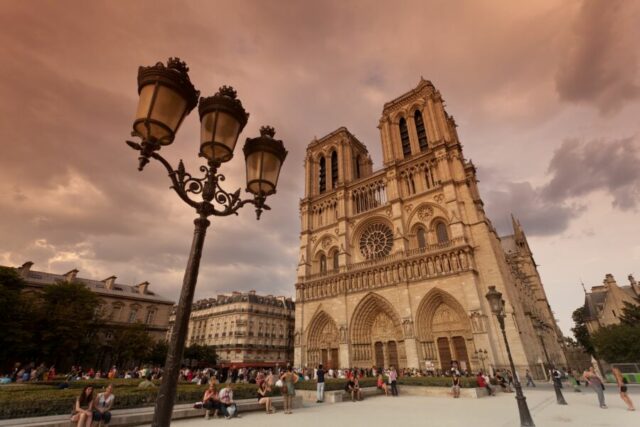The crisis of this year has overshadowed one from last year: the shocking fire at France’s top church, Notre-Dame Cathedral. Like the rest of our world right now, that cathedral is damaged and on the mend…yet it survives, as ever, as a powerful symbol of France.
The coronavirus can derail our travel plans…but it can’t stop our travel dreams. And I believe a daily dose of travel dreaming can actually be good medicine. One of the great joys of travel is seeing art masterpieces in person. And I’m currently featuring 10 of my favorites — including this one.

On an island in the center of Paris — on the spot dubbed “point zero” — stands the world’s best-known Gothic cathedral. Notre-Dame’s facade is instantly recognizable: the twin rectangular towers, the circular rose window, the three arched doorways, the rows of statues…and the impish gargoyles that line the roof.
The round rose window frames a statue of “Our Lady” (Notre Dame) to whom this church is dedicated. For centuries, Mary, the mother of Jesus, has symbolized the Christian faith’s compassionate heart. And here she stands at the heart of the facade, surrounded by the halo of the rose window. And this church stands at the heart of Paris, where the ancient Parisii tribe settled, where Romans built their pagan Temple of Jupiter, and where the Franks replaced it with a Christian church.
Imagine the faith of the people who built this massive cathedral. Countless people of high and low standing dedicated their lives to building this church, knowing it wouldn’t be finished until long after they were dead. They broke ground in the year 1163 with the hope that someday their great-great-great-great-great-great grandchildren might attend the dedication Mass. Two centuries later, in 1345, they did.
Over the centuries, the cathedral continued to evolve and undergo renovation. Recently it suffered a devastating fire (2019), requiring yet another makeover, and adding another chapter to its long history.
Stepping inside, put on a medieval pilgrim’s perspective as you soak in the ambience of this centuries-old space. Follow the slender columns up 10 stories to where Gothic arches come together like praying hands. Take in the subtle, mysterious light show that God beams through the stained-glass windows.
This is Gothic. Taller and filled with light, this was a new design needing only a few load-bearing columns, topped by crisscrossing pointed arches to support the weight of the stone roof. No longer did walls have to be thick and fortress-like to provide support — instead they could be filled with windows.
Back outside Notre-Dame, you see the gangly architectural elements of Gothic: pointed arches, tall windows, lacy stone tracery, and statues.
Most distinctive of all are the flying buttresses, the 50-foot-long stone beams that stick out from the church. They were the key to the Gothic structure. With pointed arches supporting the roof, the weight of the roof pressed outward, not down (as with earlier round arches). Flying buttresses supported that weight by pushing back in. This Gothic technology, with its skeletal structure mostly protruding on the outside, was invented in Paris in the 13th century. It enabled architects to erect lofty cathedrals with roofs supported by thin columns, allowing for “walls” of glorious stained glass.
The church’s roofline is dotted with statues of grotesque winged creatures. These bizarre beasts represented tormented souls caught between heaven and earth. They also functioned as drain spouts. When it rained, they made a gargling sound, giving us their name — gargoyles. Or maybe that’s the sound of Quasimodo as he limps along the roofline, grunting and grimacing with appreciation at this, the wonder of the High Middle Ages.
This is an excerpt from the full-color coffee-table book Europe’s Top 100 Masterpieces by Rick Steves and Gene Openshaw. Please support local businesses in your community by picking up a copy from your favorite bookstore, or you can find it at my online Travel Store. To enhance your art experience, you can find a clip related to this artwork at Rick Steves Classroom Europe; just search for “Notre Dame”.



